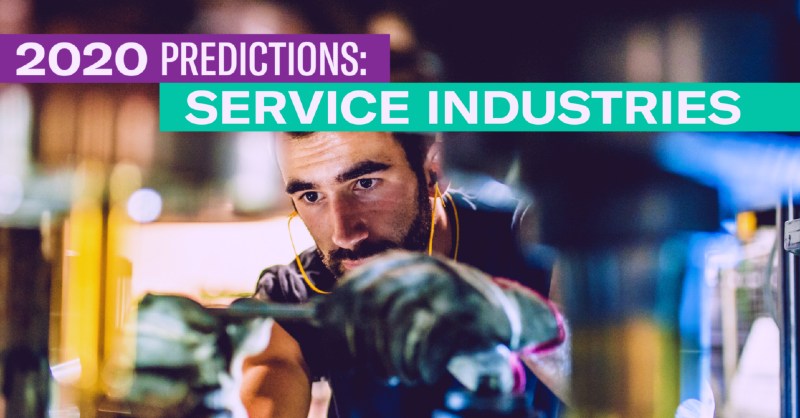These four major 2020 field service trends can take your company to new heights in service:
by Sarah Nicastro, Field Service Evangelist, IFS
In recent years, field service is evolving enormously — and technology and customer expectations will continue to advance quickly. Twenty years ago, field service trends may have been centered on break-fix repair, but the velocity now is towards long-term, contractual arrangements that are more satisfying for the customer and more lucrative for the service provider.
Transformational technologies can enable whole new revenue models that make field service organizations stickier and more intimate with their customer even while generating more value. Here are four ways leading service organizations are adapting:
Prediction 1: Outcomes-based service takes hold
We will see more companies selling annual maintenance contracts. These contracts are attractive because they give a field service organization predictable revenue and demand and can deliver high margins.
For decades, product-centric businesses have been transitioning towards servitizing what they sell. First it was the addition of a warranty and the availability of after-market parts. Then it was reactive field service or depot repair. As early as 2018, IFS data suggests that 62 percent of manufacturers were already pursuing some form of aftermarket revenue.
But manufacturers are now adopting more advanced forms of aftermarket service, with 16 percent of respondents offering maintenance contracts with specific service-level agreements (SLAs).
It is notable that modern customers not only demand a better service experience, but a holistic outcome. They expect to be left feeling positive as well as have their specific issue remedied. Technology is a mechanism whereby this change can be implemented, but nobody should overlook the people element as well.
I predict that while 16 percent of manufacturers were involved in service contracting in 2018, that number will reach 25 to 30 percent in 2020.
Complete servitization

The move towards servitization in most cases will deliver value-added revenue on top of product sales. In some cases, where it is attractive to the consumer, a product may be completely servitized, and the end user pays for metered usage or other metric captured in real time.
In the 2018 IFS data, only 4 percent of manufacturers were fully servitized, including companies from the medical device, metal fabrication and oil and gas industries.
For customers who want to push enterprise risk off on their vendors, servitization will be an attractive way to buy. But actually realizing a profit on these contracts poses some significant management and enterprise software problems.
When the service agreement is sold, a company will be committing to deliver against a contract that they could make or lose money on for years. Executives will need to make sure they have adequate what-if-scenario planning capabilities to enable them to deliver quotes that are competitive with minimal risk.
Companies can turn their data into a strategic tool that facilitates service sales while improving the customer experience. For this shift to be successful for companies, they’ve had to put some foundational technologies in place.
Research IFS and Future of Field Service recently conducted with Bill Pollock of Strategies for Growth shows that outcomes-based service operations rely on the foundation of the service management platform, ERP, predictive maintenance, and IoT in particular.
Of the survey respondents, more than half were running some type of enterprise system of record that handled the core service transactional business. And 54 percent are running their service business on a “Dedicated Service Management platform” like field service management (FSM) or enterprise asset management, just ahead of enterprise resource planning (ERP) at 50.8 percent.
But, only six percent said they were using software for predictive maintenance. This is despite that 42.8 percent were leveraging data from the internet of things (IoT).
With these tools in place, I forecast an increasing emphasis on complete servitization. What’s more, in 2020 we will see the percentage of manufacturers selling products by subscription or metered use will have risen from 4 percent in 2018 to 10 percent.
Prediction 2: Digital Transformation gets harder, then easier
People use the term “digital transformation” to sell any number of technologies, but we are dealing here not with a technology that can be bought but a fundamentally different way of looking at and doing business.
The truth is that, to do it properly, it is a complex journey for service organizations and one that involves a departure from siloed operations, legacy tools, and outdated business processes. The change management obstacles that surround this are many, as individuals can find the old ways comforting even as the competition is overtaking a business.
What we have seen so far is rollout of transformational technologies at the edge. We track our field technicians’ location through IoT. We schedule them using AI. We may have an AI chatbot fielding inquiries online. Maybe we have some AI functionality in our inventory management processes. We’ll continue to see point solutions using AI and IoT.
Where we are going next though, in field service trends, is the introduction of AI in particular to the front office and administrative processes.

In its “Top Predictions for 2020” report, Gartner said: “Through 2021, digital transformation initiatives will take large traditional enterprises, on average, twice as long and cost twice as much as anticipated. Large organizations will struggle with digital innovation as they recognize the challenges of technology modernization and the costs of simplifying operational interdependence. Smaller, more agile organizations, by contrast, will have an opportunity to be first to market as larger organizations exhibit lackluster immediate benefits.”
History is littered with companies that couldn’t change as they needed to: Kodak in the face of digital photography, Blockbuster Video in the face of servitized and downloadable media.
Today, we are at a point where disruptive technologies are embedded at the tip of the spear of forward-thinking service organizations. IoT sensors capture condition-based maintenance information, or an AI algorithm adjusts the field service schedule in real time based on constantly changing conditions.
In 2020, we will see more companies adopt these disruptive technologies in customer and service-facing settings. But I believe we will also see enterprise software vendors move further towards AI-driven automation of the front office in areas like service finance, inventory management, what-if scenario planning and customer interaction.
Moreover, those who adopt AI as part of a commercial-off-the-shelf solution will win the race against those who take a go-it-alone approach.
Prediction 3: IoT grows up — and what to do with all the data
With more and more organizations saying they have some degree of remote connectivity for their assets, their drivers, and their parts, IoT is now mainstream. We are collecting large amounts of data and can now develop and apply analytics.
In our study conducted with Strategies for Growth, the biggest area of implementation interest across all industries is in predictive and prescriptive maintenance. Connected assets are the start of the story rather than the destination and customers are starting to realize that the old adage of “garbage in, garbage out” applies if data collection and hoarding becomes an end in itself.
A good example is multinational telecom company Telefonica, a provider of smart technology to collect data from assets (such as vending machines). The data is then fed into their existing analytics for decision support. The power of analytics is significant enough that it will also be important to assure customers that you respect their privacy and data rights. Google faced controversy after its 2019 purchase of Fitbit due to concern over how Google would use and monetize end user data.
During 2020, my forecast is that businesses will focus less attention on methods by which to collect additional data and more on making valuable use of the data they are already collecting.
Prediction 4: Companies to balance AI vs human experience
As advanced AI becomes more widely adopted among service organizations, companies will seek an equilibrium between the efficiencies of AI and contact with humans that customers and other stakeholders crave.
On one hand, greater AI use not only reduces costs but also enables organizations to make better use of resources in sectors facing labor shortages. AI will do a better job meeting certain deliverables and should automate many repetitive tasks. Will this free up staff for more customer-facing work?
In various service settings, this is exactly what AI has already done. AI-driven schedule optimization, for instance, enables a single dispatcher to support a larger number of field service technicians, enabling them to manage by exception, perhaps spending more time with customers when they need a human touchpoint.
Service intelligence vendor Aquant acknowledges that although Fortune Magazine had in 2016 warned that 48 percent of jobs would be lost to artificial intelligence and robotics, Aquant says in this Field Services Online article that the true future lies in a hybrid between people and AI.
And as noted by Deloitte in its report Smart Field Service: Connecting Customers, Assets and Employees, “In a digital world, it’s emotional connections that make the difference between satisfying experiences and those that delight the customers and build strong long-term customer relationships.”
Our job now is to use AI to engineer seamless, satisfying automated processes into our business without engineering the human contact out.
About the author:

Sarah Nicastro is Field Service Evangelist at IFS. Sarah has over a decade of experience covering the field service trends, technologies and business drivers that most impact end users of field service solutions from her tenure as Editor-in-Chief at Field Technologies Online. You can see more of her articles about field service here.
Learn more about IFS and quickly connect on the company’s directory page.
And for more field service trends and success stories, be sure to check out MobileVillage’s field service page.





